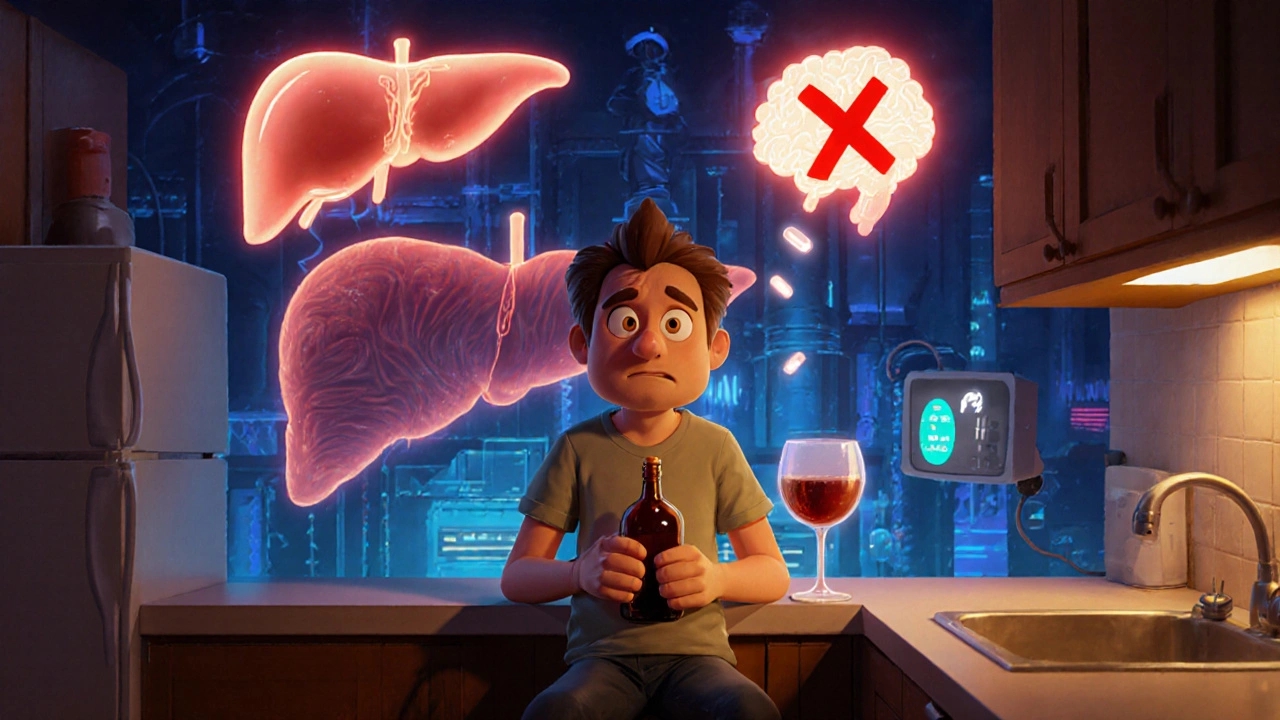More than 40% of adults taking prescription or over-the-counter medications are at risk of dangerous reactions when they drink alcohol. It’s not just about getting drunk faster. Alcohol can turn your medicine into something unpredictable-too strong, too weak, or even toxic. This isn’t rare. It’s happening right now, in homes, pharmacies, and emergency rooms across the country.
How Alcohol Changes How Your Medicines Work
Your liver is the main workplace where alcohol and medications meet. Both are broken down by the same enzymes-especially CYP2E1, CYP3A4, and CYP1A2. When you drink, your liver gets busy processing alcohol. That slows down how fast your body clears your medicine. The result? Higher levels of the drug in your blood, sometimes by 25% to 75%. That can mean dizziness, drowsiness, or worse.
On the flip side, if you drink alcohol regularly over weeks or months, your liver starts making more of these enzymes. That speeds up how fast your body breaks down the medicine. Suddenly, your pill isn’t working like it should. Your blood pressure stays high. Your anxiety returns. Your pain isn’t controlled.
But it’s not just about metabolism. Alcohol can also team up with your medicine to amplify its effects. This is called a pharmacodynamic interaction. Take benzodiazepines like diazepam or alprazolam-they already slow down your brain. Add alcohol, and that slowdown becomes dangerous. Together, they can depress your breathing so much that you stop breathing. Studies show this combo increases GABA activity in your brain by up to 400%. That’s not a typo. It’s a medical emergency waiting to happen.
Medications That Can Kill You With Just One Drink
Some medicines have no safe level of alcohol. These are the ones you absolutely cannot mix.
- Metronidazole (Flagyl) and tinidazole: These antibiotics cause a disulfiram-like reaction. One drink can trigger flushing, vomiting, rapid heartbeat, and chest pain. In 92% of cases, symptoms show up within 30 minutes. ER visits from this combo are common.
- Disulfiram (Antabuse): This drug is used to stop people from drinking. It makes your body react violently to alcohol-even a sip. It’s designed to make you sick. Don’t test it.
- Linezolid: An antibiotic used for serious infections. With alcohol, it can cause a sudden, life-threatening spike in blood pressure.
These are Category 1 drugs-absolute no-go zones. If you’re prescribed any of these, put the bottle away. No exceptions. Not even one sip. Not even one beer at a party. Not even a glass of wine with dinner. The risk isn’t worth it.
High-Risk Combinations You Might Not Realize Are Dangerous
Then there are the drugs where even moderate drinking can be risky.
- Benzodiazepines (Xanax, Valium, Ativan): These are sedatives. Alcohol is a sedative. Together, they can shut down your breathing. This combination causes 32% of all alcohol-medication deaths, according to CDC data.
- Opioids (oxycodone, hydrocodone, morphine): These already slow your breathing. Alcohol adds to that. The CDC says mixing them increases the risk of fatal respiratory depression by eight times.
- Antidepressants (SSRIs like fluoxetine, sertraline): Alcohol can make you feel more dizzy or depressed. It can also make your medication less effective over time. One study found people who drank while on SSRIs stayed intoxicated 3.2 hours longer than usual.
- Antihistamines (Benadryl, Zyrtec, Claritin-D): These make you sleepy. Alcohol makes you sleepier. Combine them, and you might fall asleep behind the wheel-or stop breathing in your sleep.
- Sleep aids (Ambien, Lunesta): These are designed to knock you out. Alcohol pushes you into a deeper, more dangerous sleep. No one wakes up from this combo easily.
These are Category 2 drugs. If you take any of these, you need to cut alcohol way back-or stop entirely. There’s no safe middle ground.
Over-the-Counter Medicines Are Just as Dangerous
People think OTC means safe. It doesn’t.
- Acetaminophen (Tylenol): This is the most common painkiller in the U.S. But when you drink alcohol regularly-even just 2 or 3 drinks a day-it turns into a liver bomb. Studies show 18% of people who combine daily alcohol with acetaminophen develop signs of liver damage. The FDA warns against more than 3 drinks a day with acetaminophen. But Mayo Clinic research found even moderate drinking can raise liver enzymes in nearly half of users.
- NSAIDs (ibuprofen, naproxen, aspirin): These are hard on your stomach. Alcohol is too. Together, they can cause bleeding in your gut. One study found the risk jumps by 300% to 500%. That’s not a small chance. That’s a real threat.
- Cough syrups and cold meds: Many contain antihistamines, alcohol, or dextromethorphan. Drinking while taking these can lead to confusion, hallucinations, or coma.
These aren’t just side effects. They’re preventable emergencies.

Who’s Most at Risk-and Why
It’s not just about what you take. It’s about who you are.
People over 65 are at higher risk because their livers process alcohol slower. Blood flow to the liver drops by about 35% between ages 25 and 75. That means drugs and alcohol hang around longer. The American Geriatrics Society lists 17 medications that are especially dangerous for older adults when mixed with alcohol.
People taking five or more medications are also at higher risk. Nearly 70% of seniors take five or more pills a day. Each one adds another chance for interaction. Alcohol doesn’t care if you’re on blood pressure meds, diabetes pills, or heart rhythm drugs. It just reacts.
And men and women don’t process alcohol the same way. Women have less water in their bodies and lower levels of the enzyme that breaks down alcohol. That means even one drink hits them harder. The same amount of alcohol can lead to higher blood levels in women than in men.
What You Should Do Right Now
You don’t need to guess. Here’s what to do:
- Check every prescription. Look at the label. Look at the patient information sheet. If it doesn’t mention alcohol, ask your pharmacist. They’re trained to spot these risks.
- Know your standard drink. One drink = 12 oz beer (5% alcohol), 5 oz wine (12%), or 1.5 oz spirits (40%). Anything else isn’t a standard drink. Don’t assume a glass of wine or a pint of beer is safe.
- Wait 72 hours. If you’re starting metronidazole, tinidazole, or disulfiram, don’t drink for at least three days before and after. That’s the only way to be sure.
- If you must drink, do it smart. For Category 3 drugs like SSRIs or NSAIDs, wait at least 2-3 hours after taking your pill. Eat food first. Limit to one drink for women, two for men. Never drink on an empty stomach.
- Use a trusted tool. The Alcohol and Medication Interaction Risk Calculator (AMIRC) from NIAAA is free and online. It asks about your meds, your drinking, your age, and your liver health. It gives you a risk score.
Why Doctors Don’t Always Warn You
It’s not your fault if you didn’t know. Only 42% of prescription bottles include a warning about alcohol. A 2021 FDA audit found most labels are vague or missing entirely.
And only 28% of Medicare Annual Wellness Visits include alcohol screening-even though seniors who drink while on meds are 50% more likely to be hospitalized.
Most doctors don’t ask. They assume you don’t drink. Or they assume you know. But 68% of patients say they were never told about alcohol risks by their prescriber.
Pharmacists are often the last line of defense. Walgreens data shows that when a pharmacist gives you a clear warning, 89% of people change their behavior. That’s powerful. Don’t be shy. Ask your pharmacist when you pick up a new prescription.

Real Stories, Real Consequences
One Reddit user wrote: “Took one beer with my metronidazole and ended up in the ER with vomiting and a heart rate of 180.” That’s not an exaggeration. That’s a documented reaction.
Another shared: “My pharmacist warned me about hydroxyzine and wine. Saved me from what would’ve been a disaster at my sister’s wedding.”
These aren’t outliers. They’re examples. Drugs.com has over 78,000 user reports of bad reactions. The most common? Extreme drowsiness, nausea, and trouble walking. These are the early signs. If you feel them, stop drinking. Stop taking the medicine. Call someone.
What’s Changing-and What’s Next
The FDA now requires new warning labels on high-risk medications. Starting in 2024, you’ll see pictograms-simple icons showing alcohol is dangerous with that drug.
Telehealth platforms are now asking patients about alcohol use during virtual visits. More pharmacies are flagging risky combinations before the prescription is filled.
But the biggest gap? Medical schools. Only 39% of U.S. medical schools teach alcohol-medication interactions as part of their core curriculum. That means many doctors graduate without knowing how to explain this risk.
So you have to be your own advocate. Don’t wait for someone to tell you. Ask. Check. Verify.
Final Rule: When in Doubt, Skip It
You don’t need to be a scientist to stay safe. You just need to be careful.
If your medicine says ‘may cause drowsiness,’ skip the drink.
If your medicine says ‘take with food,’ don’t take it with a cocktail.
If your medicine has a black box warning, alcohol is probably part of the danger.
There’s no such thing as ‘just one drink’ when your liver is already busy fighting your meds. The cost of that one drink isn’t just a hangover. It could be a hospital stay. Or worse.
Alcohol and medication interactions aren’t a myth. They’re a silent killer. And you have the power to stop it.
Can I have one glass of wine with my blood pressure medication?
It depends on the medication. Some blood pressure drugs like ACE inhibitors or beta-blockers can cause dizziness or a sudden drop in blood pressure when mixed with alcohol. Even one glass can make you feel lightheaded or increase your risk of falling. If you’re unsure, skip it. If you want to drink, wait at least two hours after taking your pill, eat something first, and limit yourself to one small glass. But the safest choice? Don’t mix them at all.
What if I only drink on weekends?
If you take a daily medication, weekend drinking still matters. Your body doesn’t reset quickly. For drugs like antidepressants, painkillers, or statins, alcohol on Saturday can still affect you on Sunday-even if you didn’t drink on Friday. The interaction isn’t just about timing. It’s about how long the drug stays in your system. Some, like diazepam, can linger for days. If you’re on a long-term medication, treat alcohol like a daily risk-not just a weekend one.
Does alcohol affect all medications the same way?
No. Some medications, like metronidazole, react violently even with a sip. Others, like certain statins or thyroid meds, have little to no interaction. But you can’t tell just by looking. That’s why checking every new prescription is critical. The only safe rule? Assume alcohol interacts unless proven otherwise. Never guess.
Can I drink after I finish my antibiotic course?
For most antibiotics, yes-once you’re done. But for metronidazole, tinidazole, or linezolid, wait at least 72 hours after your last dose. Even a small amount of alcohol during that time can cause dangerous reactions. Don’t assume it’s safe just because you’re done taking the pills. Check the label or ask your pharmacist. The risk doesn’t disappear the moment you stop the medicine.
I’ve been drinking with my meds for years. Is it too late to stop?
It’s never too late to make a change. Your liver is resilient. Stopping alcohol-even now-can reduce your risk of liver damage, stomach bleeding, and overdose. If you’ve been drinking regularly with your meds, talk to your doctor about a liver function test. You might be surprised how much your body can recover. The sooner you stop, the better your chances.

